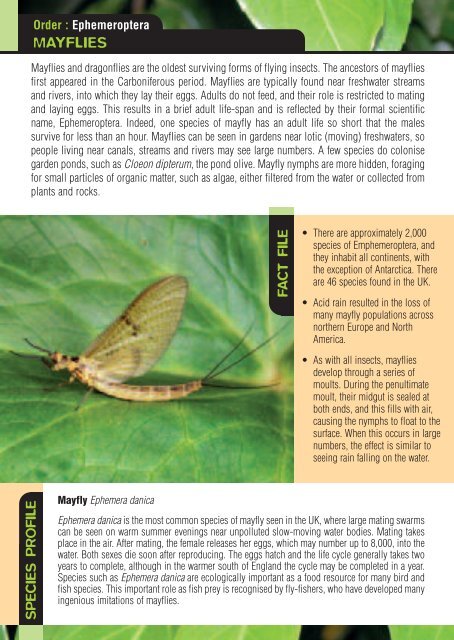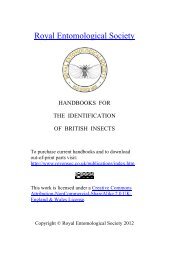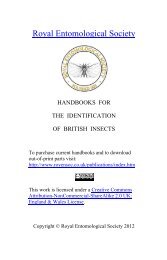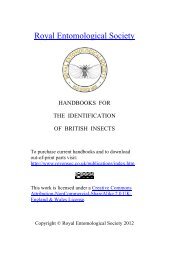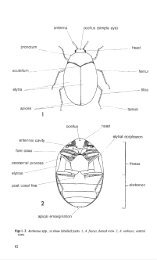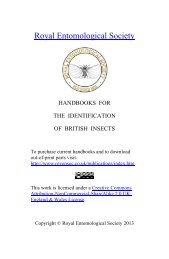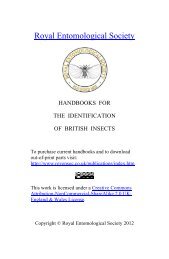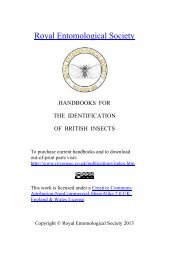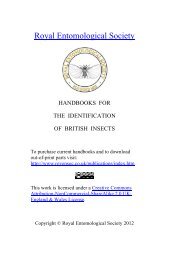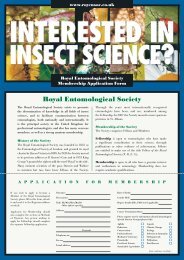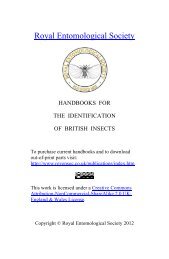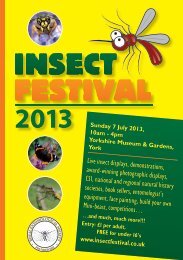Garden Entomology - Royal Entomological Society
Garden Entomology - Royal Entomological Society
Garden Entomology - Royal Entomological Society
You also want an ePaper? Increase the reach of your titles
YUMPU automatically turns print PDFs into web optimized ePapers that Google loves.
SPECIES PROFILE<br />
Order : Ephemeroptera<br />
MAYFLIES<br />
Mayflies and dragonflies are the oldest surviving forms of flying insects. The ancestors of mayflies<br />
first appeared in the Carboniferous period. Mayflies are typically found near freshwater streams<br />
and rivers, into which they lay their eggs. Adults do not feed, and their role is restricted to mating<br />
and laying eggs. This results in a brief adult life-span and is reflected by their formal scientific<br />
name, Ephemeroptera. Indeed, one species of mayfly has an adult life so short that the males<br />
survive for less than an hour. Mayflies can be seen in gardens near lotic (moving) freshwaters, so<br />
people living near canals, streams and rivers may see large numbers. A few species do colonise<br />
garden ponds, such as Cloeon dipterum, the pond olive. Mayfly nymphs are more hidden, foraging<br />
for small particles of organic matter, such as algae, either filtered from the water or collected from<br />
plants and rocks.<br />
FACT FILE<br />
• There are approximately 2,000<br />
species of Emphemeroptera, and<br />
they inhabit all continents, with<br />
the exception of Antarctica. There<br />
are 46 species found in the UK.<br />
• Acid rain resulted in the loss of<br />
many mayfly populations across<br />
northern Europe and North<br />
America.<br />
• As with all insects, mayflies<br />
develop through a series of<br />
moults. During the penultimate<br />
moult, their midgut is sealed at<br />
both ends, and this fills with air,<br />
causing the nymphs to float to the<br />
surface. When this occurs in large<br />
numbers, the effect is similar to<br />
seeing rain falling on the water.<br />
Mayfly Ephemera danica<br />
Ephemera danica is the most common species of mayfly seen in the UK, where large mating swarms<br />
can be seen on warm summer evenings near unpolluted slow-moving water bodies. Mating takes<br />
place in the air. After mating, the female releases her eggs, which may number up to 8,000, into the<br />
water. Both sexes die soon after reproducing. The eggs hatch and the life cycle generally takes two<br />
years to complete, although in the warmer south of England the cycle may be completed in a year.<br />
Species such as Ephemera danica are ecologically important as a food resource for many bird and<br />
fish species. This important role as fish prey is recognised by fly-fishers, who have developed many<br />
ingenious imitations of mayflies.


